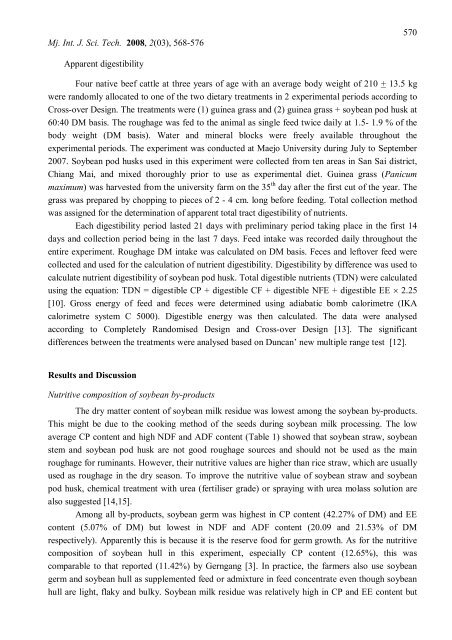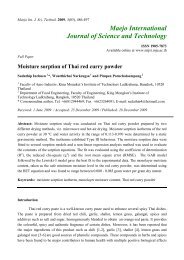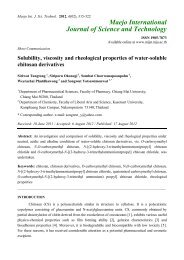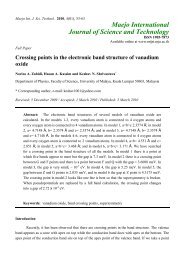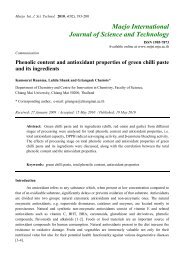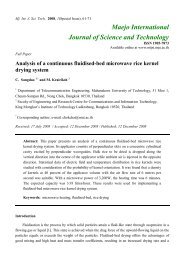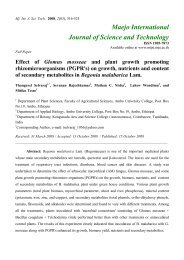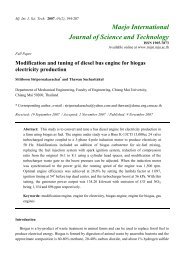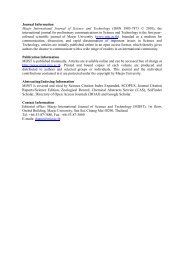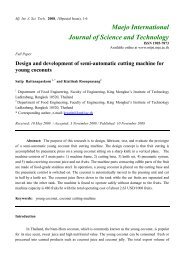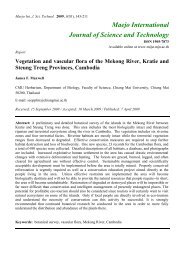Nutritive composition of soybean by-products and nutrient ...
Nutritive composition of soybean by-products and nutrient ...
Nutritive composition of soybean by-products and nutrient ...
You also want an ePaper? Increase the reach of your titles
YUMPU automatically turns print PDFs into web optimized ePapers that Google loves.
Mj. Int. J. Sci. Tech. 2008, 2(03), 568-576570Apparent digestibilityFour native beef cattle at three years <strong>of</strong> age with an average body weight <strong>of</strong> 210 + 13.5 kgwere r<strong>and</strong>omly allocated to one <strong>of</strong> the two dietary treatments in 2 experimental periods according toCross-over Design. The treatments were (1) guinea grass <strong>and</strong> (2) guinea grass + <strong>soybean</strong> pod husk at60:40 DM basis. The roughage was fed to the animal as single feed twice daily at 1.5- 1.9 % <strong>of</strong> thebody weight (DM basis). Water <strong>and</strong> mineral blocks were freely available throughout theexperimental periods. The experiment was conducted at Maejo University during July to September2007. Soybean pod husks used in this experiment were collected from ten areas in San Sai district,Chiang Mai, <strong>and</strong> mixed thoroughly prior to use as experimental diet. Guinea grass (Panicummaximum) was harvested from the university farm on the 35 th day after the first cut <strong>of</strong> the year. Thegrass was prepared <strong>by</strong> chopping to pieces <strong>of</strong> 2 - 4 cm. long before feeding. Total collection methodwas assigned for the determination <strong>of</strong> apparent total tract digestibility <strong>of</strong> <strong>nutrient</strong>s.Each digestibility period lasted 21 days with preliminary period taking place in the first 14days <strong>and</strong> collection period being in the last 7 days. Feed intake was recorded daily throughout theentire experiment. Roughage DM intake was calculated on DM basis. Feces <strong>and</strong> leftover feed werecollected <strong>and</strong> used for the calculation <strong>of</strong> <strong>nutrient</strong> digestibility. Digestibility <strong>by</strong> difference was used tocalculate <strong>nutrient</strong> digestibility <strong>of</strong> <strong>soybean</strong> pod husk. Total digestible <strong>nutrient</strong>s (TDN) were calculatedusing the equation: TDN = digestible CP + digestible CF + digestible NFE + digestible EE 2.25[10]. Gross energy <strong>of</strong> feed <strong>and</strong> feces were determined using adiabatic bomb calorimetre (IKAcalorimetre system C 5000). Digestible energy was then calculated. The data were analysedaccording to Completely R<strong>and</strong>omised Design <strong>and</strong> Cross-over Design [13]. The significantdifferences between the treatments were analysed based on Duncan’ new multiple range test [12].Results <strong>and</strong> Discussion<strong>Nutritive</strong> <strong>composition</strong> <strong>of</strong> <strong>soybean</strong> <strong>by</strong>-<strong>products</strong>The dry matter content <strong>of</strong> <strong>soybean</strong> milk residue was lowest among the <strong>soybean</strong> <strong>by</strong>-<strong>products</strong>.This might be due to the cooking method <strong>of</strong> the seeds during <strong>soybean</strong> milk processing. The lowaverage CP content <strong>and</strong> high NDF <strong>and</strong> ADF content (Table 1) showed that <strong>soybean</strong> straw, <strong>soybean</strong>stem <strong>and</strong> <strong>soybean</strong> pod husk are not good roughage sources <strong>and</strong> should not be used as the mainroughage for ruminants. However, their nutritive values are higher than rice straw, which are usuallyused as roughage in the dry season. To improve the nutritive value <strong>of</strong> <strong>soybean</strong> straw <strong>and</strong> <strong>soybean</strong>pod husk, chemical treatment with urea (fertiliser grade) or spraying with urea molass solution arealso suggested [14,15].Among all <strong>by</strong>-<strong>products</strong>, <strong>soybean</strong> germ was highest in CP content (42.27% <strong>of</strong> DM) <strong>and</strong> EEcontent (5.07% <strong>of</strong> DM) but lowest in NDF <strong>and</strong> ADF content (20.09 <strong>and</strong> 21.53% <strong>of</strong> DMrespectively). Apparently this is because it is the reserve food for germ growth. As for the nutritive<strong>composition</strong> <strong>of</strong> <strong>soybean</strong> hull in this experiment, especially CP content (12.65%), this wascomparable to that reported (11.42%) <strong>by</strong> Gerngang [3]. In practice, the farmers also use <strong>soybean</strong>germ <strong>and</strong> <strong>soybean</strong> hull as supplemented feed or admixture in feed concentrate even though <strong>soybean</strong>hull are light, flaky <strong>and</strong> bulky. Soybean milk residue was relatively high in CP <strong>and</strong> EE content but


